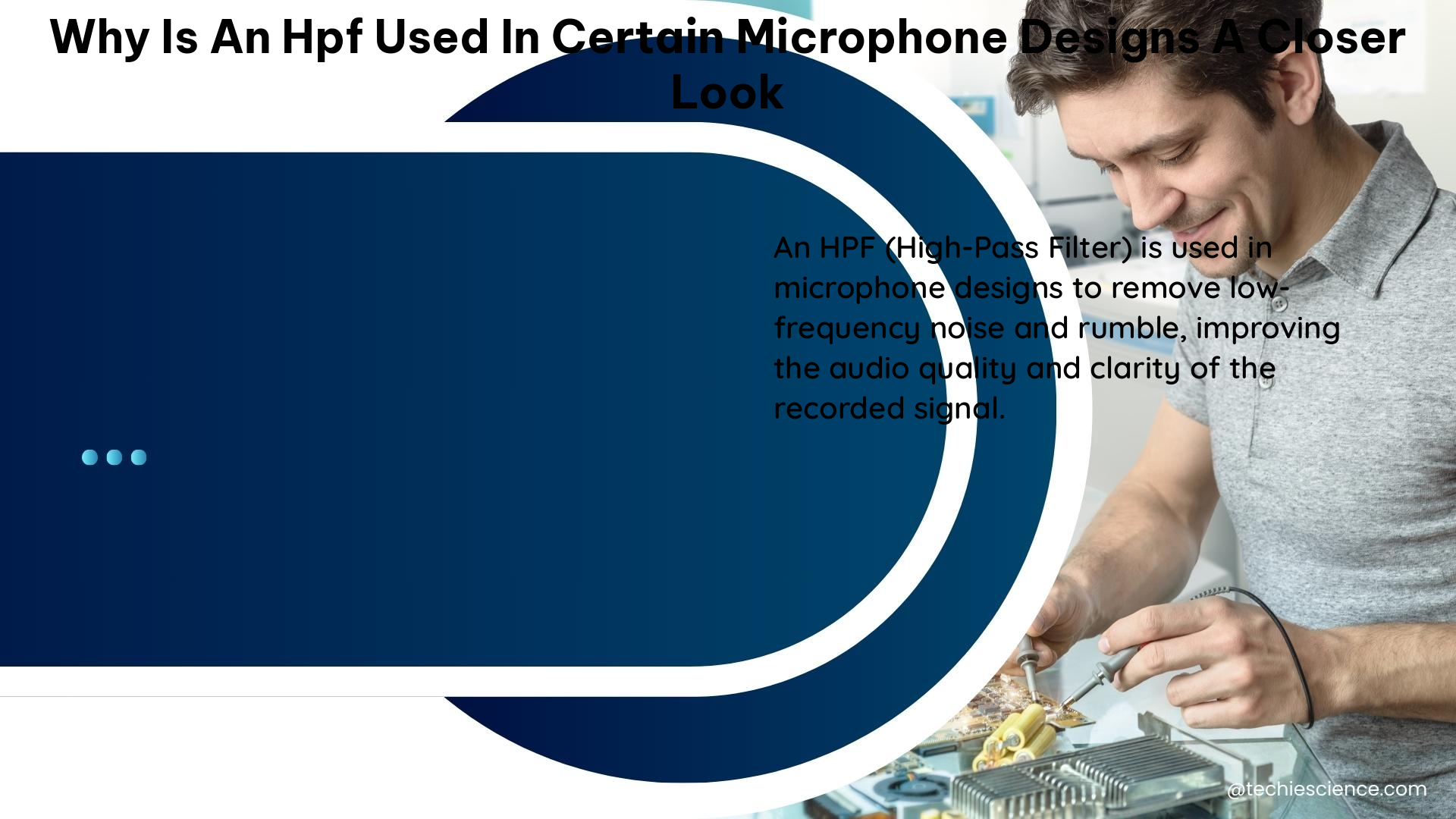High-Pass Filters (HPFs) are commonly used in various microphone designs to address specific audio challenges and optimize the performance of the microphone. This article will provide a comprehensive and technical exploration of the reasons behind the use of HPFs in certain microphone designs.
Understanding the Proximity Effect and Subsonic Noise
The primary reasons for using an HPF in microphone designs are to counter the proximity effect and remove unwanted subsonic noise.
Proximity Effect
The proximity effect is a phenomenon where the low-frequency response of a microphone is boosted when the sound source is placed in close proximity to the microphone. This effect is caused by the increased air pressure at the diaphragm of the microphone, which results in an amplification of the low-frequency content. The proximity effect can be particularly problematic for vocalists who tend to work in close proximity to the microphone.
To address the proximity effect, microphone designers often incorporate an HPF with a gentle, 6dB/octave slope starting above 100Hz. This filter helps to attenuate the low-frequency boost caused by the proximity effect, ensuring a more natural and balanced frequency response.
Subsonic Noise
In addition to the proximity effect, microphones can also pick up unwanted subsonic noise, such as mechanical vibrations or air currents. This low-frequency noise can interfere with the desired audio signal and degrade the overall sound quality.
To mitigate the impact of subsonic noise, microphone designers may include a rumble filter, which is a type of HPF with a much steeper slope, typically 12 or even 18 dB/octave. These rumble filters are designed to remove the unwanted subsonic noise while preserving the useful frequency content of the audio signal.
Microphone Specifications and HPF Turnover Frequency

When evaluating microphone specifications, the HPF turnover frequency is an important parameter to consider. The turnover frequency is the point at which the filter begins to attenuate the signal, and it is typically expressed in Hertz (Hz).
For example, the Lewitt LCT 1040 microphone has a switchable HPF with a turnover frequency of 120Hz. This filter is designed to counter the proximity effect by attenuating the low-frequency boost that occurs when the microphone is placed in close proximity to the sound source.
In contrast, a rumble filter typically has a lower turnover frequency, such as 80Hz, 60Hz, or even 40Hz. These lower turnover frequencies are well below the useful frequency content of speech, vocals, and most acoustic instruments, ensuring that the essential audio information is preserved while the unwanted subsonic noise is effectively removed.
Passive Band-Pass Filters in Microphone Design
When designing a passive band-pass filter for a microphone, it is crucial to consider the range of frequencies that best describes the human voice. Traditionally, the human voice range was considered to be 300 Hz to 3000 Hz. However, for singing, it is recommended to include at least a couple of octaves of overtones, which would extend the upper limit to around 6000 Hz or higher.
Designing a passive band-pass filter for a microphone can be a challenging task, especially at very low microphone levels. The complexity arises due to the need to balance the attenuation of unwanted frequencies while preserving the desired audio content.
Alternative Approaches to Feedback Reduction
Due to the challenges associated with passive band-pass filters, microphone designers often opt for alternative approaches to address feedback issues. One common solution is the use of notch-filters, which are designed to selectively attenuate specific frequencies without affecting the rest of the audio spectrum.
Another alternative approach is the use of software-based frequency shifters. These digital signal processing (DSP) techniques can shift the microphone signal up by a few Hertz, which can effectively eliminate feedback issues. However, this approach may come at the cost of slightly confusing the vocalist, as the shifted audio may not match their expected perception.
Conclusion
In summary, HPFs are commonly used in certain microphone designs to counter the proximity effect and remove unwanted subsonic noise. The HPF turnover frequency is a crucial specification to consider, as it determines the frequency range at which the filter begins to attenuate the signal.
While passive band-pass filters can be used in microphone design, they can be challenging to implement, especially at low microphone levels. As a result, microphone designers often turn to alternative approaches, such as notch-filters or software-based frequency shifters, to address feedback issues without significantly affecting the desired audio content.
By understanding the technical details and considerations behind the use of HPFs in microphone designs, audio engineers and enthusiasts can make informed decisions when selecting and configuring microphones for their specific applications.
References:
– Sound on Sound – Will Mics’ High-Pass Filter Counter Proximity Effect?
– Sound Stack Exchange – Bandpass Filter on Omnidirectional Microphone: Experimenting
– Wikipedia – Butterworth Filter
– Microphone Design and Application, Second Edition, by Richard C. Heyser and Milton W. Sachs
– Electronic Filter Design Handbook, by Arthur E. Bryant and Donald R. Cauer
– Network Analysis and Feedback, by Hendrik W. Bode

The lambdageeks.com Core SME Team is a group of experienced subject matter experts from diverse scientific and technical fields including Physics, Chemistry, Technology,Electronics & Electrical Engineering, Automotive, Mechanical Engineering. Our team collaborates to create high-quality, well-researched articles on a wide range of science and technology topics for the lambdageeks.com website.
All Our Senior SME are having more than 7 Years of experience in the respective fields . They are either Working Industry Professionals or assocaited With different Universities. Refer Our Authors Page to get to know About our Core SMEs.